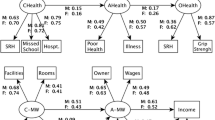Abstract
We investigate the impact of health shocks on wealth, using all four waves of the Health and Retirement Study, and estimate not only the short-term effect but also the long-term effect of health shocks on wealth of the elderly. We find that new health events lower wealth in elders during the period in which such health shocks occur, but the impact tends to disappear over time. We also find that health shocks result in greater wealth depletion when they occur later in life. Together with existing health problems, the overall impact of health problems on wealth increases over time.
Similar content being viewed by others
Notes
For example, if t = 3, \(\Delta W_{3} = \alpha _{3} X + \beta _{2} \Delta H_{1} + \beta _{1} \Delta H_{2} + \beta _{0} \Delta H_{3} \).
We did not use the 1993 data because a recent study found that wealth in the first wave of AHEAD was underreported (Rohwedder et al. 2004). A substantial, unreliable increase in wealth was found in the follow-up interview, and it was concluded that the chances of correcting this error in a reliable manner are slim.
None of the three instrumental variables were significant for the estimation of the 1995/2002 period, whereas although only one instrumental variable (exercise) was significant to predict existing health for the other two periods (1995/1998 and 1995/2000).
References
Adams P, Hurd MD, McFadden D, Merrill A, Ribeiro T (2003) Healthy, wealthy, and wise? tests for direct causal paths between health and socioeconomic status. J Econom 112(1):3–56
DuMouchel WH, Duncan GJ (1983) Using sample survey weights in multiple regression analyses of stratified samples. J Am Stat Assoc 78(382):535–543
GAO, U.S. General Accounting Office (2001) Medigap insurance: Plans are widely available but have limited benefits and may have high costs (GAO-01-941). Washington, DC (available at http://www.gao.gov/new.items/d01941.pdf)
Haider S, Hurd M, Reardon E, Williamson S (2000) Patterns of dissaving in retirement. The Public Policy Institute, AARP, Washington, DC
Heeringa SG, Connor JH (1995) Technical description of the health and retirement survey sample design. The Institute for Social Research, University of Michigan, Ann Arbor, MI
HHS, U.S. Department of Health and Human Services (2003) A profile of older Americans: 2003. Rockville, MD (available at http://www.aoa.gov/prof/Statistics/profile/ 2003/ 2003 profile.pdf)
HHS, U.S. Department of Health and Human Services (2004) Health care expenses in the United States, 2000 (AHRQ Publication. no.04-0022). Rockville, MD (available at http://www.meps.ahrq.gov/papers/rf21_04-0022/rf21.pdf)
Hurd M, Kapteyn A (2003) Health, wealth, and the role of institutions. Labor and population program, Working Paper Series 03–09, Rand Corporation, Santa Monica, CA
Hurd M, Reardon E (2003) Real wealth changes from 1982 to 1991 among the newly retired. labor and population program, Working Paper Series 03–15, Rand Corporation, Santa Monica, CA
Hwang W, Weller W, Ireys H, Anderson G (2001) Out-of-pocket medical spending for care of chronic conditions. Health Aff 20(6):267–278
Juster FT, Smith JP (1997) Improving the quality of economic data: Lesson from the HRS and AHEAD. J Am Stat Assoc 92(440):1268–1278
Koenker R, Bassett G Jr (1978) Regression quantiles. Econometrica 46(1):33–50
Lee J, Kim H (2003) An examination of the impact of health on wealth depletion in elderly individuals. J Gerontol B Psychol Sci Soc Sci 58(2):S120–S126
McGarry K, Schoeni RF (1995) Transfer behavior in the health and retirement study: Measurement and the redistribution of resources within family. J Hum Resour 30:S184–S226, (special issue)
Modigliani F, Brumberg R (1954) Utility analysis and the consumption function: An interpretation of cross-section data. In: Kurihara KK (ed) Post-keynesian economics. Rutgers University Press, New Brunswick, NJ
Rohwedder S, Haider SJ, Hurd M (2004) Increases in wealth among the elderly in the Early 1990s: how much is due to survey design? NBER Working Paper no. w10862
Sloan F, Zhang HH, Wang J (2002) Upstream intergenerational transfers. South Econ J 69(2):363–380
Smith JP (1997) The changing economic circumstances of the elderly: Income, wealth, and social security. Center for Policy Research Policy Brief No. 8, Maxwell School of Citizenship and Public Affairs, Syracuse University, Syracuse, NY
Smith JP (1999) Healthy bodies and thick wallets: the dual relation between health and economic status. J Econ Perspect 13(2):145–166
Smith JP (2003) Consequences and predictors of new health events. presented at the NBER conference on economics of aging, Boulder, Arizona
Smith JP, Kington RS (1997a) Race, socioeconomic status, and health in later life. In: Martin LG, Soldo BJ (eds) Racial and ethnic differences in the health of older Americans. National Academy Press, Washington, DC, pp 106-162
Smith JP, Kington RS (1997b) Demographic and economic correlates of health in old age. Demography 34(1):159–170
University of Michigan (2002) Sampling weights revised for tracker 2.0 and beyond (available at http://hrsonline.isr.umich.edu/meta/tracker/desc/wghtdoc.pdf)
Wallace RB, Herzog AR (1995) Overview of the health measures in the health and retirement study. J Hum Resour 30(Supplement):84–107
Winship C, Radbill L (1994) Sampling Weights and regression analysis. Sociol Methods Res 23(2):230–257
Wolff J, Starfield B, Anderson G (2002) Prevalence, expenditures, and complications of multiple chronic conditions in the elderly. Arch Intern Med 162(20):2269–2276
Wu S (2003) The effects of health events on the economic status of married couples. J Hum Resour 38(1):219–230
Yaari ME (1965) Uncertain lifetime, life insurance, and the theory of the consumer. Rev Econ Stud 32(2):137–150
Acknowledgements
Lee and Kim acknowledge the anonymous referees for their comments.
Author information
Authors and Affiliations
Corresponding author
Additional information
Responsible editor: Junsen Zhang
Rights and permissions
About this article
Cite this article
Lee, J., Kim, H. A longitudinal analysis of the impact of health shocks on the wealth of elders. J Popul Econ 21, 217–230 (2008). https://doi.org/10.1007/s00148-007-0156-5
Received:
Accepted:
Published:
Issue Date:
DOI: https://doi.org/10.1007/s00148-007-0156-5




